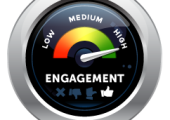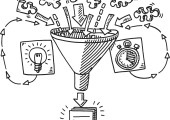There is a lot of buzz among marketers about fostering customer engagement, building engagement with apps and websites, creating communities with blogs and social selling. It all sounds great on paper, we should all work together, share your purchases socially, everybody knows everything you do, everyone’s on your side, we’re all a village, cumbaya . . . But when you’re standing in the aisle at Wal-Mart deciding what frozen dinner brand or dog food to buy, I don’t feel that my level of engagement with Purina’s website is the deciding factor. Marketing is about raising awareness in a positive way to influence and drive SALES. I can be as engaged as can be with a brand, but if a similar product is in front of me, and they are largely the same, engagement doesn’t trump quality, availability and price, and the sale will go to the one who fits those three criteria the closest. Even with B2B sales, I’ve been “engaged” with a number of websites and businesses prospecting my business via e-mail and other devices, but haven’t actually bought anything from any of them – I’d score really high on their “engagement scale” algorithm, but they haven’t made a dime off of me, and may never do so.
Brand engagement is a long-term play. It needs to be tied to other awareness vehicles, timed promotions, backup media, and ongoing evolution of product benefit awareness in order to really be effective at driving sales. This is not a new idea, but it’s one which has risen to prominence recently along with the ubiquity of social media platforms, which provide the ability for person-to-person communication in a way heretofore not possible on the current scale. I can now tell thousands of people what I’m doing, what I’m interested in, what I’m buying, what I’m eating, cooking, enjoying, drinking, and more on a moment’s notice in real time. That means that if I’m sharing it with others, it’s boosting their awareness as well as my own for a particular product, service or item. That kind of organic, exponential awareness spread at that speed was unheard of just 15 years ago. Epidemiologists are familiar with the concept, but marketers only recently began to apply it to their efforts – indeed the term “going viral” is borrowed from the disease spread specialists, as information, or awareness, can spread a lightning speed unseen from the outside, like a virus.
Just because I’m aware of a product or service that I’ve engaged with it on the Internet, does not mean that when the time comes I’m actually going to make a purchase. It may increase the odds some, but as we learned with the recent Powerball drawing, odds need to be changed significantly with a supreme effort in order to really affect the outcome. Social media engagement or website engagement is like buying 100 lottery tickets instead of one. It seems like you’ve boosted your chances of winning by 100 fold, but in reality, those other 99 tickets didn’t even move the needle.
By all means, do A/B testing, make adjustments, formulate campaigns that include a mechanism for increasing engagement, but depending upon it to drive significant revenue could be a mistake. The basics of building ongoing awareness through media your audience utilizes, timing your efforts to coincide with that target’s needs or life-stage position, matching your demographics and psychographics and messaging to that of the prospective customer, are still the linchpins of successful marketing efforts, and enhancements and refinements to these, along with some boosts in awareness through effective promotion of specialty offers, benefit driven messaging, and creative imagery, will drive revenue upward on a consistent basis as the brand evolves and the audience grows. If you’ve got all those bases covered effectively, engagement is a nice to have, the icing on the cake, and a good set up for the upsell and cross sell to that customer base, due to the added time allowed for an opportunity to develop.
Unless I miss my guess, the folks dwelling on engagement (which is notoriously hard to measure with any accuracy) don’t have all the basics in place and need a buzz word and a crutch to help them explain why things on the sales side aren’t moving as far or as fast as expected.
Dwell on the basics of marketing, make sure all the right pieces are in place and working together efficiently, and keeping the pipeline full, then worry about engagement.





